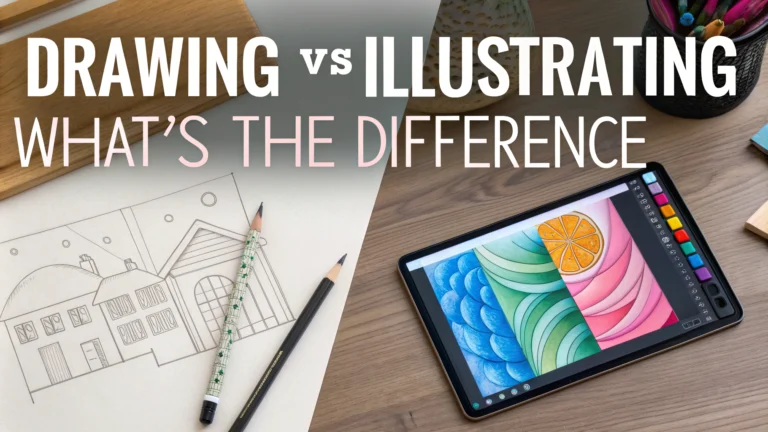Many aspiring artists find themselves wondering about the distinctions between **drawing** and **illustrating**. While these creative practices share common elements, they serve different purposes and require distinct skill sets.
Understanding these differences helps artists choose the right path and develop the specific techniques needed for their chosen medium. This quick guide breaks down the fundamental contrasts between drawing and illustration to help you make informed decisions about your artistic journey.
Understanding Basic Terminology and Core Concepts
- Drawing: A fundamental artistic skill focused on creating marks, lines, and shapes
- Illustration: The art of creating images with a specific commercial or storytelling purpose
- Medium: The materials and tools used to create artwork
Essential Tools and Materials
| Drawing | Illustration |
|---|---|
|
• Pencils • Charcoal • Sketch pads • Erasers |
• Digital tablets • Software • Mixed media • Specialized markers |
Primary Purpose and Applications
- **Drawing** primarily serves as:
- Personal artistic expression
- Skill development
- Preliminary sketches
- **Illustration** focuses on:
- Commercial projects
- Story communication
- Client specifications
Career Paths and Professional Opportunities
- Drawing-focused careers:
- Fine artist
- Art instructor
- Concept artist
- Illustration careers:
- Book illustrator
- Editorial illustrator
- Commercial artist
“Drawing is the foundation of all visual arts, while illustration is its practical application in the commercial world.” – Industry perspective
The Essential Guide to Drawing and Illustration
Drawing and illustration represent distinct art forms, each with unique purposes and techniques. This quick guide helps artists understand key differences to make informed choices about their creative path.
Core Elements and Tools
A solid grasp of art fundamentals sets up success in both disciplines. **Drawing** relies on:
- Freehand sketching ability
- Understanding of form and perspective
- Line quality and shading techniques
Career Development Strategies
Building a successful career requires specific approaches:
- **Drawing Focus:**
- Build a diverse portfolio
- Master traditional techniques
- Network with galleries and art communities
- **Illustration Focus:**
- Develop industry-specific portfolios
- Learn relevant software
- Connect with potential clients
Pricing and Business Models
Different pricing structures apply to each field:
| Drawing | Illustration |
|---|---|
|
• Original artwork sales • Commission-based • Teaching/workshops |
• Project-based fees • Licensing rights • Retainer arrangements |
Technical Skills and Software
Modern artists need both traditional and digital skills:
- Essential software: Adobe Creative Suite, Procreate
- Traditional media mastery
- Color theory and composition
Client Communication and Project Management
Professional success depends on:
- Clear project briefs
- Regular client updates
- Meeting deadlines
- Managing revisions
Building Your Portfolio
Create targeted portfolios that showcase:
- Best work examples
- Range of styles
- Problem-solving abilities
- Industry-specific projects
Moving Forward in Your Art Career
Success in either field requires:
“Focus on continuous improvement and adaptability to market demands.”
Consider these action steps:
- Join professional organizations
- Attend industry events
- Create an online presence
- Develop passive income streams
Remember: The choice between drawing and illustration isn’t permanent – many artists successfully combine both disciplines throughout their careers.
FAQs About Drawing vs Illustrating
General Questions
Q: What’s the main difference between drawing and illustration?
A: Drawing is a general artistic technique focusing on creating marks, lines, and shapes, while illustration is a commercial art form created specifically to communicate ideas, stories, or messages.
Q: Can all illustrators draw?
A: Most professional illustrators have strong drawing skills, but they also use additional techniques and tools, including digital software, to create commercial artwork.
Q: Are illustrations worth more than drawings?
A: Commercial illustrations typically command higher prices than drawings because they’re created for specific business purposes and often involve more complex production processes.
Technical & Career Questions
Q: What software do professional illustrators use?
A: Professional illustrators commonly use:
- Adobe Illustrator
- Procreate
- Photoshop
- Clip Studio Paint
Q: How much do freelance illustrators make vs traditional artists?
A: Freelance illustrators in the US typically earn $45,000-$85,000 annually, while traditional artists’ income varies widely, from $20,000-$70,000+.
Q: What education is needed for illustration vs drawing careers?
A: While formal education isn’t mandatory for either, illustration often requires:
- Commercial art training
- Software proficiency
- Understanding of marketing principles
Specific Applications
Q: Can you make money drawing vs illustrating children’s books?
A: Children’s book illustration typically offers more consistent income opportunities, with illustrators earning $3,000-$12,000 per book, while drawing sales depend on art market variables.
Q: What’s better for concept art – drawing or illustration skills?
A: Concept art requires both drawing fundamentals and illustration techniques, with emphasis on digital illustration skills for industry work.
Q: Is digital drawing the same as digital illustration?
A: Digital drawing focuses on creating traditional drawing effects digitally, while digital illustration encompasses broader commercial art techniques and often includes elements like vector graphics and photo manipulation.
Q: Which pays more: medical illustration or fine art drawing?
A: Medical illustration typically pays more, with median salaries of $70,000-$90,000 annually, compared to fine art drawing’s variable income structure.
| Aspect | Drawing | Illustration |
|---|---|---|
| Primary Purpose | Artistic expression | Commercial communication |
| Tools Used | Traditional media | Mixed media + digital |
| Career Focus | Fine arts | Commercial arts |



















